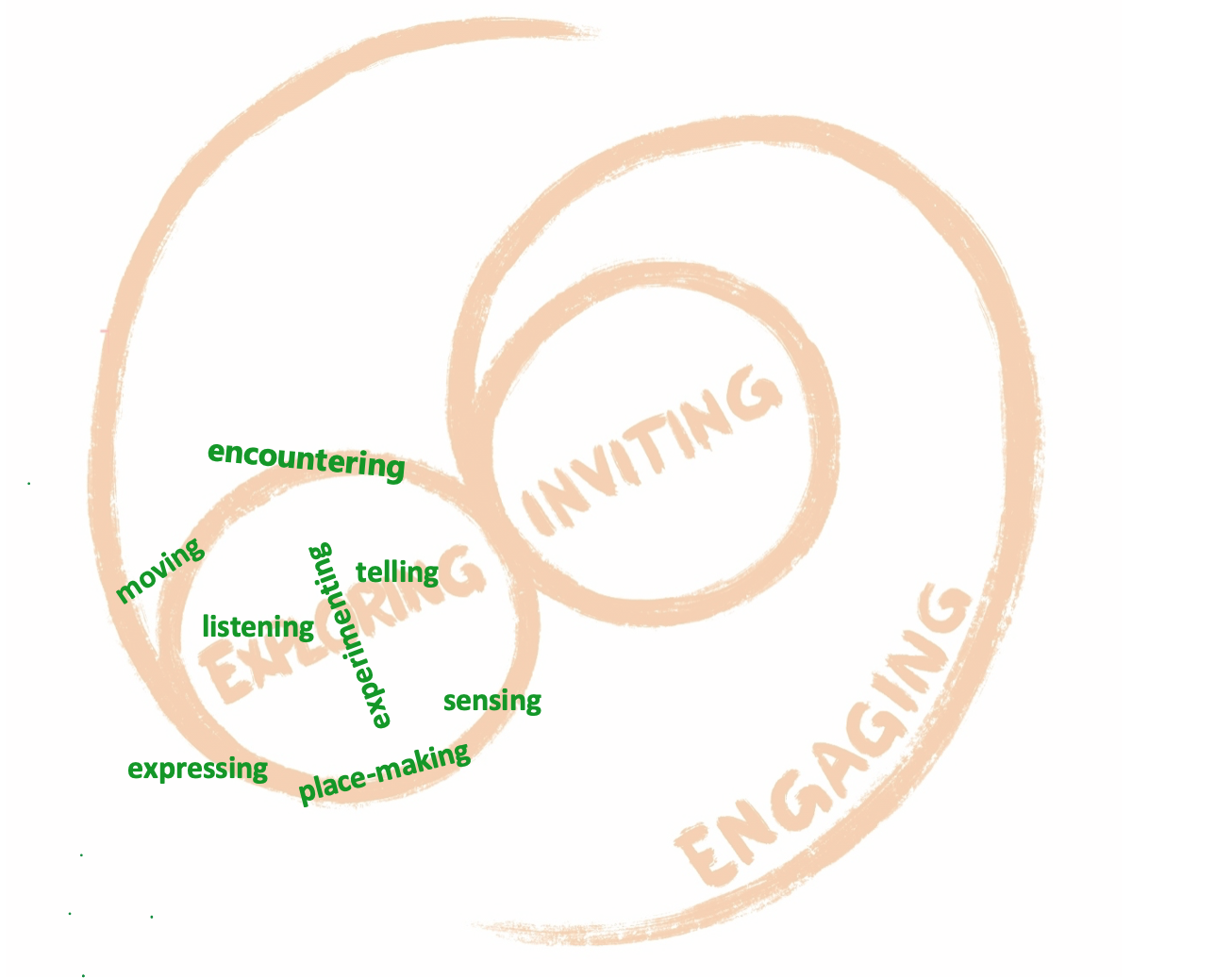Exploring
Description
The first learning movement consists of 4 components: placemaking (1), an introduction to the PIMDI context (2), the choice for an urgent theme (3) and based on this, group formation (4) through initial exploratory work.
The emphasis lies on growing an awareness of being in difference, on a first probing to bring each other’s divergent perspectives and experiences into dialogue. These perspectives can be tied to differences in background, disciplines, culture, gender, nature-landscape, worldview, expectations, goals, and desires. As part of the PIMDI methodology, all activities are characterized as open frames and/or propositions to be interpreted by the participants in explorative ways. Dialogue is seen as sensorial, as ‘more than verbal’.
This movement of exploring involves both teacher-initiated exercises and propositions performed by the whole group, and of student driven experiments in the subgroups. As for these teacher-driven exercises, one of these involves supporting a process of ‘placemaking’: to set the scene in order to help students create co-ownership of their shared location, to make it a place in which everyone can feel a sense of belonging in their own way.
The teacher’s work also involves introducing the PIMDI context, specifically the underlying idea and the notion of imaginative dialogues, and proposing a theme that ties in with urgent issues in society challenging students to formulate their own, different, perspectives on this. Teachers will also offer examples of existing forms of dialogue to the provisional subgroups of students. These dialogues work as ‘kick starters’ to help students formulate a burning question (we call this ‘a campfire’) in relation to the given theme. In doing so they will begin to get a notion of different perspectives within the group.
While working on this, students share their real-life experiences in embodied and spatial ways and derive inspiration from both their encounters and the environment. This works as a basis for individual, conscious choices as to which subgroup one feels belonging to.
Components and movements

This movement is about being conscious of your personal perspectives and experiences, as well as a growing awareness of interhuman, interesting or unsettling differences.
Examples
Some preparatory teacher-driven propositions that open the senses to the environment create a basic sense of trust between students and introduce what an imaginative dialogue is. This involves setting the scene exercise for place-making, an exercise to start building a community, an exercise for a close encounter with another participant, and an exercise to experience what an imaginative dialogue can be.
For building a community:
Ask students to bring, share and tell a story about a piece of food that is connected to their cultural background and/or to the natural environment they live in.
For place making:
Ask students to bring an object that is connected to a sense of ‘home’ and to tell a story about this to the other students. The objects will be placed in a communal room.
For a close encounter:
Practice ‘radical listening’(LINK) in pairs for half an hour. Two participants sit together, facing towards each other at a distance of 1 meter. One person asks one question and after that only listens, holding the space and noting what stands out about what the other person says and does. Attention is also paid to body language. After 15 minutes, the listener reads aloud what has been noted. Then the participants switch roles.
To explore an example of what an imaginative dialogue can do as a kick starter for the process:
This example derives from Subversive Affirmation (Kicurovska & Cornelis, 2022).
Think with your hands or prototype. Rapid prototyping workshop.
Introducing situations:
· Work in pairs. Think of 2 situations with an obvious experienced tension related to the theme the Paradox of Safety & Transgression.
· Each pair introduces these 2 situations to the others, and each pair selects one of the situations from the other.
Affirm
· Affirm what you just heard by visualizing the situation using the materials supplied to you. Try to identify the specific elements that mark the situation, what strikes you especially?
· Ultra short presentation of the prototypes. Clarifying questions can be asked.
Subvert
· Each pair takes over another pairs’ prototype.
· Subvert the affirmative prototype by adjusting it, exaggerating it, or repurposing it.
· Ultra short presentation of the prototypes. Clarifying questions can be asked.
· Give both prototypes a title
Some student-driven propositions that are shared to gather experiences connected to the theme are found here.

Learning
Learning is not directed solely at the students; in the process, teachers and students learn together.
Awareness:
– the ability to persist in not knowing
– openness and curiosity
– explore assumptions
– suspension of judgement
– embodied and sensory experience, naming and exploring
Arts pedagogical sensitivity:
– to pay attention to own perceptions and those of others
– to be able to register differences in attitude and awareness
– to be able to facilitate a safe and challenging dialogue space
– to be able to use your own medium/discipline to deepen the dialogue (listen, interact, speak, and create differently).
